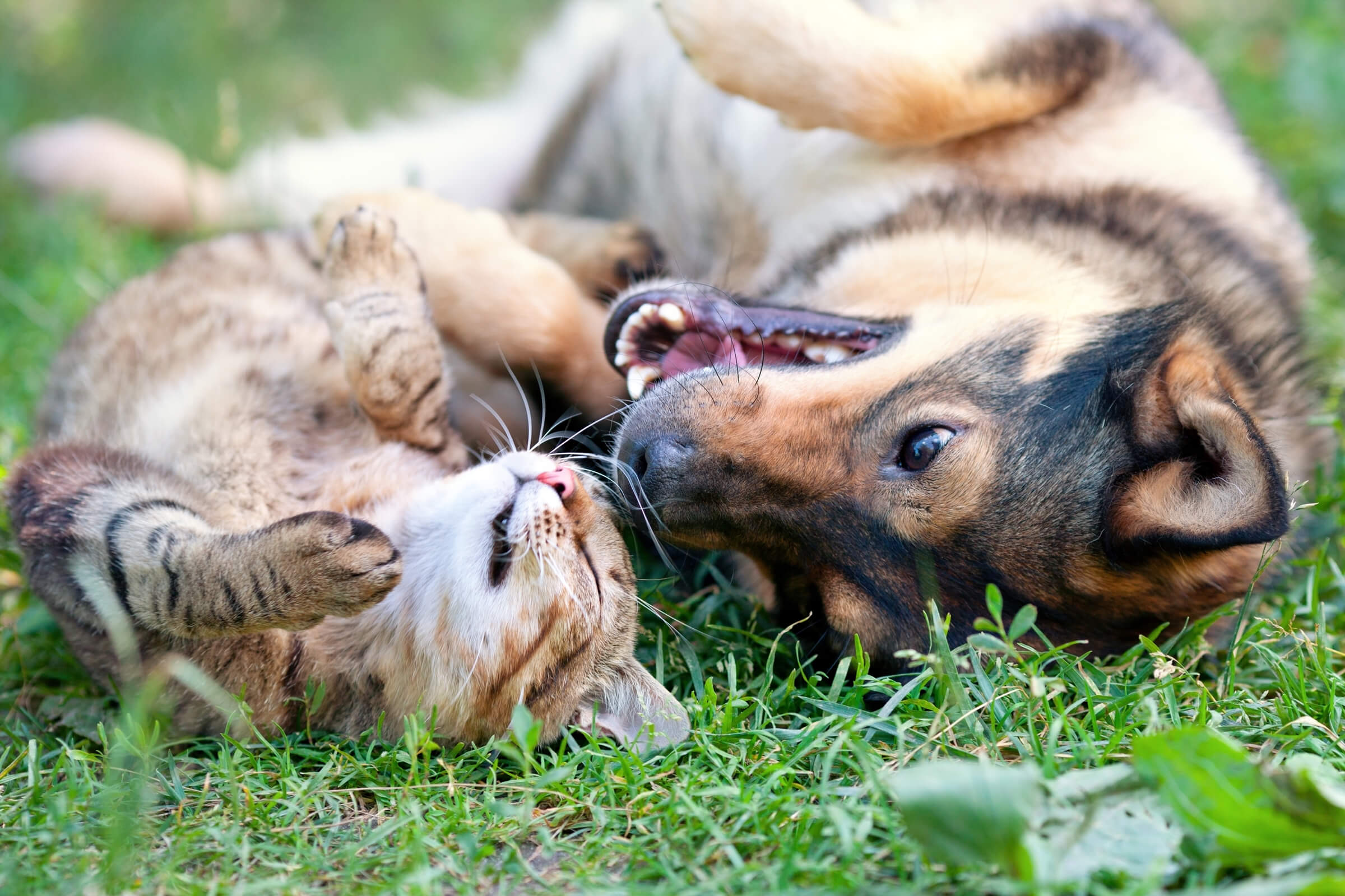
 Menu
Menu
Cranial Cruciate Ligament Disease (Canine)

What is the cranial cruciate ligament?
There are four main ligaments in the stifle (knee joint) of a dog; two outside called the collateral ligaments and two inside the joint called the cruciate ligaments (so called because they form a cross shape). The cruciate ligament nearest the front of the joint is the cranial cruciate ligament (CCL), the equivalent to the anterior cruciate ligament or ACL in a human. The ligament attaches the femur (thigh bone) to the tibia (shin bone), preventing the tibia from moving forward relative to the femur. It also helps to prevent over-extension and rotation.
What causes cruciate ligament disease in dogs?
Rupture of this ligament in humans is often trauma-related. However in dogs, it is frequently a degenerative condition with genuinely traumatic cases being particularly uncommon.
Although this is common ailment, we do not fully understand why this condition develops in dogs. We know some breeds are more commonly affected (Labradors, Rottweilers, Golden Retrievers, Boxers) and some breeds are relatively protected (sighthounds for example greyhounds & whippets) but the exact cause remains unclear. Some breeds may have conformational abnormalities which predispose to this condition for example some Bichon Frise or West Highland White terriers can have tibial anatomy which increases pressure on the ligament. As this is a degenerative condition we often use the term ‘cranial cruciate ligament disease’ rather than ‘cranial cruciate ligament rupture’
How can I tell if my dog has cruciate ligament disease?
The most common sign of cranial cruciate ligament disease is limping on the back leg. In dogs this can occur suddenly but in others it may develop slowly. There is a lot of variation in the degree of limping; some dogs cannot put any weight on the leg whereas with others the limp can be subtle. Some dogs show stiffness after rest and others get worse after exercise. Occasionally both stifles can be affected at once meaning the dog cans struggle to get up and can even mimic a patient with a spinal problem.
How is cranial cruciate ligament disease diagnosed?
A positive diagnosis can be straightforward if the ligament is completely ruptured and is usually confirmed on examination by an experienced orthopaedic surgeon. When a partial tear is present this can be more difficult to diagnose as there is not the same degree of instability in the joint. Other tests may be required such as radiography (x-rays) or assessment under anaesthesia / sedation. Radiographs may show signs consistent with the presence of osteoarthritis which is commonly present in dogs with cranial cruciate ligament disease. In most dogs, exploratory surgery or arthroscopy (keyhole surgery) is used to confirm the ligament is damaged. The cartilage in the joint will also be assessed as meniscal (cartilage) damage can often occur along with CCL disease.
Management options of cranial cruciate ligament disease
Non-surgical / conservative management
This type of management uses weight control, exercise control, rehabilitation, non-steroidal anti-inflammatory drugs and dietary supplements. However, this offers a very unpredictable outcome and for this reason it is not commonly recommended in our clinic. Dogs undergoing this management may improve in the earlier phases of treatment but longer term outcomes are often poor. Small dogs may respond better than bigger dogs but again the outcome is unpredictable.
Surgical management
Many different techniques have been described for treatment of this condition and for a long time the outcomes were considered similar. However, there is growing body of recent evidence which suggests TPLO (tibial plateau levelling osteotomy), which is our favoured choice of treatment, offers the best outcome.
- Ligament substitute
- Tibial Plateau Levelling Osteotomy (TPLO)
- Cranial closing wedge ostectomy (CWO)
- Tibial Tuberosity Advancement (TTA)
The cranial cruciate ligament can be substituted by using the patient’s own tissue, which is a favoured technique in humans. The ‘over the top’ technique was the mainstay of treatment for many years but evidence suggests the outcomes are unpredictable with the substitute ligament undergoing degeneration and the overall strength of the substitute ligament is weak compared to the original. This technique has now fallen out of failure among specialists.
Using a prosthetic ligament has now been available for many years (lateral extracapsular suture or fabellotibial suture). Nylon is often used as the substitute ligament material, secured by knotting or with a metallic crimp but the suture stretches or breaks over time and the patient can return to the pre-operative status in the early phases of recovery. Recently, more robust materials have been developed (Fiberwire®) which do not fatigue in the same way. The TightRope® technique utilises Fiberwire® which has been shown to have some encouraging outcomes.
These techniques may have a better outcome where the injury relates to trauma, as the knee was a ‘normal’ joint prior to injury. With genuine traumatic cranial cruciate ligament ruptures other ligaments may be affected and can be managed using the same ligament substitute material – we call this a multi-ligamentous or a global knee injury.
In recent studies, this procedure has been shown to be the technique most likely to return maximal limb function and as such is our favoured technique. The TPLO procedure does not rely on the presence of the ligament but instead changes the forces in the joint to create a more stable ‘platform’ when the dog is weight bearing on the leg. A semi-circular cut is made in the top of the tibia (shin bone) and the top section of bone is ‘levelled’ to improve stability in the joint. The cut bone is stabilised with a bone plate and screws. Once the bone is healed the procedure is complete. Although the bone is cut, this is well tolerated procedure with many dogs weight bearing on the leg within 48 hours of surgery.
This technique also levels the top section of the tibia in a similar way to TPLO but by removing a wedge of bone rather than using a curved cut. This was the predecessor surgery to TPLO and is occasionally used in some patients especially some small breeds. The bone is again stabilised with a bone plate and screws.
This technique also uses a cut in the top of the tibia (shin bone) but in this case the front of the knee is ‘pushed’ forwards to change the forces in the knee. The recent literature does not support the same outcomes as with TPLO. This technique also has a higher incidence of cartilage injury after surgery (late meniscal injury) compared to TPLO. Very few patients are considered suitable candidates for this procedure in our clinic.
Outcome
We expect most patients (90%) of patients to have a good to excellent outcome following TPLO. We expect dogs to be able to return to off-lead exercise and be free of medication. Athletic, performance or working dogs may be able to return to work or competition but may not quite achieve the same levels of ability after surgery although some do. Much in the way that human athletes may not return to the same level of competition as pre-operatively.
Potential complications after cruciate ligament repair surgery?
For our most commonly performed surgery, TPLO, complications rates are low when performed by experienced surgeons. The most common complication is infection. If infection is detected approximately 50% of dogs will respond to antibiotic therapy. The others may require implant removal at a later date if the infection fails to clear. This does not tend to affect long term outcome.
Late meniscal injury is possible and occurs in a small number (1-2%) of cases. Some patients respond to anti-inflammatory drug but other need the damaged section of cartilage removed.
Fracture of the tibial tuberosity or fibular are uncommon. These are often healing fractures not requiring further management unless deviation of the bone has developed.
Failure of the surgical implants is where the bone plate or screws bend, break or loosen from the bone. This can cause significant disruption to the surgery site and is typically associated with over-activity in the early postoperative period.
Keeping patients appropriately confined after surgery and adhering to the post-operative care plan given by the surgeon keeps the complication rate to a minimum although this does not completely eliminate all risk.
Stay in touch
Follow us on social media and keep up to date with all the latest news from the MVS clinic.



